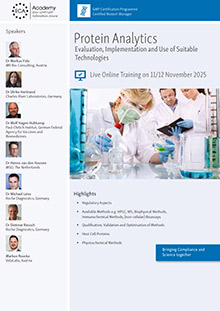Inspectors' Aide Memoire on Process Validation - a Detailed Analysis

Recommendation
5/6 February 2026
With the Annex 15 revision, the issue of process validation became significantly more complicated. What is the authority's view on process validation nowadays? In order to reach a uniform approach, the German Central States' Authority (ZLG - Zentralstelle der Länder für Gesundheitsschutz bei Arzneimitteln und Medizinprodukten) has issued a new aide memoire on process validation.
The 47-page document describes how the general principles of validation and QRM should be applied to process validation. These general principles are/will be described in additional aide memoires.
The introduction discusses the innovation caused by the revision of Annex 15. Process validation is a life cycle model now and starts with the development of a process (process design). The control strategy which accompanies the process routine and which is repeatedly confirmed during ongoing process verification is very important. The introduction also covers the three (new) validation approaches (traditional, continuous process verification, hybrid) as well as the increased importance of risk assessment, which is now required for all phases of the product life cycle.
The subchapter on "Process development as a basis for process validation" introduces new terms such as quality target product file, critical and non-critical quality attributes as well as critical and non-critical process parameters and material attributes. Scale-up and pilot batches have special significance in this aide memoire. Furthermore, the approaches to development (minimal/empirical approach and the extended QbD approach) known from ICH Q8 are explained and advantages and disadvantages are discussed. Because of the poor knowledge so far with QbD processes, the aide memoire recommends to consult experts (e.g. assessors) for the inspection of such processes, depending on the expertise of the GMP inspectors.
The subchapter on acceptable approach to process validation describes the three validation approaches. For traditional validation based on the minimal development approach, there is explicit mention that a three-batch initial validation is possible in the future as well. The number and extent of the batches should be based on a risk analysis in that case. An initial validation with less than three batches is deemed possible depending on the experience with similar processes. Regarding GMP inspections, the aide memoire advises inspectors to examine those aspects that are not part of the approval documentation. Ongoing process verification is only examined during GMP inspections.
The aide memoire demands the following GMP requirements on process validation:
- GMP-compliant requirements within the QA system
- Performance according to requirements
- Appropriate and scientifically sound validation design
The quality manual should contain a declaration of voluntary undertaking of the management on the provision of resources. There is explicit mention of the fact that process validation is also obligatory for subcontractors. Nineteen minimum requirements for an approach to process validation are listed, which should be included in an SOP or validation master plan. The required entries in a validation master plan (6 entries) are also mentioned. One of the six entries is the description of a bracketing approach, where applicable.
An individual subchapter describes the staff responsibilities regarding process validation. It specifies the heads of production and of quality control, the qualified person, QA units, the validation team and external consultants.
The organisational procedure and documentation of a process validation are rather briefly described with emphasis on consecutive validation batches and references in the documents in order to clearly allocate them to validation projects. The requirements for performing a process validation are discussed in ten points.
The topic of risk assessment is discussed in greater extent in the aide memoire. It is interesting to note that the aide memoire demands the quantification of risk levels for this purpose. Possible examples such as risk priority numbers, but also categorisation into other/major/critical are named. Regarding the latter categorisation, non-formalised risk management tools can be used as well.
Then twenty-two points are described as being required for a validation protocol and an individual subchapter explains bracketing requirements. Very modern, the subchapter on batch size also addresses continuous production and batch size range. Regarding the latter, a bracketing approach is expected. The aide memoire states that it is not necessary to run the process out of the limits during a process validation. However, predictable variations of the production process (e.g. different active ingredient batches, different machines, varying process parameters or stand and hold times, variation of the environmental conditions, shift operation) should be considered. The importance of sampling plans is explained, but a random statistical sample is not explicitly requested. Eleven minimum requirements are also listed. The document specifically mentions release of validation batches and especially releases before the completion of a validation (e.g. during a concurrent validation).
The ongoing process verification (OPV) will replace a periodic revalidation according to the aide memoire. The purpose of the OPV is to provide information on the process performance in the course of a monitoring programme. That requires a monitoring plan and periodic reports. The scope of the programme must be defined risk-based. In the context of an OPV, trend analyses are requested in particular. Depending on the necessity of reliable statements, the aide memoire also addresses statistical methods and indices regarding OPV.
In a separate subchapter, process changes and technology transfers are discussed. The very extensive chapter 2 ends with an excursus on QbD-associated process management and process control. In this subchapter, information on design space, PAT, SPC and real time release testing (RTRT) are in turn described in further subsections. The subsection on SPC also discusses process performance and capability indices in great detail.
Finally, a third chapter lists definitions and abbreviations.
Conclusion: The new aide memoire on process validation displays the current view of the authority on process validation and is highly readable for that reason alone, but also because of its partially specific requirements. Participants of the event Process Validation in the light of the revised Annex 15 and FDA Requirements on 25/26 April 2018 in Frankfurt/Germany will exclusively receive an English-language translation.





